If you have been following this blog, you know that there has been a 5-day hiatus in the posts. In part that is because I had gotten up to where we had finished the interesting, initial part of our trip and were settling into a month of work in Dunedin. Also, however, I expected that whoever might be interested in our musings would be at least as interested in those of Taylor and Haywood, who have been blogging about their trip through the North Island at http://taylormwright.com/.
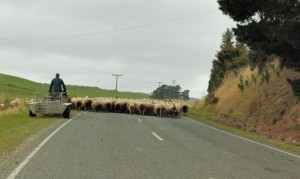 So the day had finally come ending the pure vacation part of this trip. Saying Goodbye to Helen and Graeme, we started the car up the road to Dunedin. Our first obstacle was a flock of sheep being driven to a new pasture along the highway (State Highway #1 even if it doesn’t look that large). Shades of our episode with the cows just two days before, however, this time the farmer’s wife was in a car at the back of the herd telling us that we should drive on through and they would move. Nina, who was driving again today, shared my trepidation about this maneuver; however, we watched a truck just plow through coming from the other direction and, as we inched forward, sure enough these big, wooly sheep got out of the way.
So the day had finally come ending the pure vacation part of this trip. Saying Goodbye to Helen and Graeme, we started the car up the road to Dunedin. Our first obstacle was a flock of sheep being driven to a new pasture along the highway (State Highway #1 even if it doesn’t look that large). Shades of our episode with the cows just two days before, however, this time the farmer’s wife was in a car at the back of the herd telling us that we should drive on through and they would move. Nina, who was driving again today, shared my trepidation about this maneuver; however, we watched a truck just plow through coming from the other direction and, as we inched forward, sure enough these big, wooly sheep got out of the way.
Another obstacle was that we were driving through the Catlins, the gorgeous coastal area that is the southeast part of the South Island. However, rain was coming on and we had an apartment to get to and food and other things to find and purchase in order to settle in. So except for a few stops – here at Florence Point – we mostly just drove through.
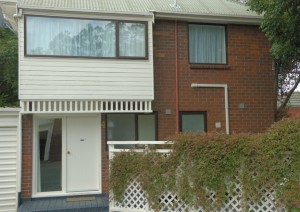 This is our home for the next month: 30 Heriot Row, Apt. 4. We have this entire building, a 3 bedroom apartment, with a kitchen, living-dining room, two shower rooms (one with a washer and, unusual for here, dryer – mostly people use lines), and one toilet room. This is more than enough for us, even when the girls join us later for a week. We had hoped that we might entice someone else to come to visit – but it is a LONG way.
This is our home for the next month: 30 Heriot Row, Apt. 4. We have this entire building, a 3 bedroom apartment, with a kitchen, living-dining room, two shower rooms (one with a washer and, unusual for here, dryer – mostly people use lines), and one toilet room. This is more than enough for us, even when the girls join us later for a week. We had hoped that we might entice someone else to come to visit – but it is a LONG way.
[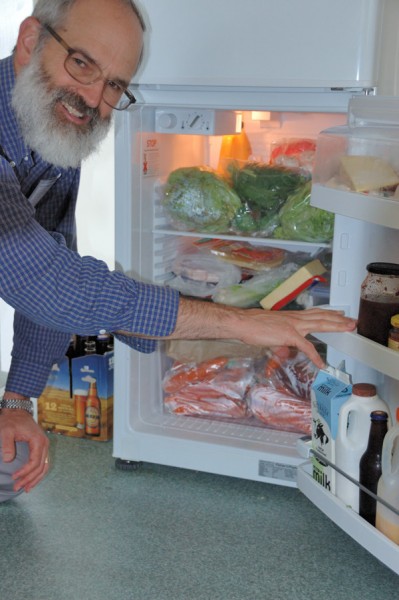 It might seem strange to some, but I am planning to cook most of our meals here. The kitchen, although smaller than at home and only marginally well equipped, is adequate for that (although those of you who know me well, know that I have brought my own knives). The only serious problem is that I feel a little like Gulliver with this Lilliputian refrigerator. Here it is on a Saturday after we have been to the farmers market.
It might seem strange to some, but I am planning to cook most of our meals here. The kitchen, although smaller than at home and only marginally well equipped, is adequate for that (although those of you who know me well, know that I have brought my own knives). The only serious problem is that I feel a little like Gulliver with this Lilliputian refrigerator. Here it is on a Saturday after we have been to the farmers market.
The apartment is on one of the hills above Dunedin. The photo below is the view out over the city from where we are. The water in the middle distance is Otago Harbor. It is at the end of a 20 km channel to the Pacific Ocean, protected by Otago Peninsula. The land in the middle distance is that peninsula, which connects to the mainland off to the right of this picture. Although, it is not possible to see, the Pacific is also just on the other side of this peninsula, and the beaches in South Dunedin are on the Pacific. The channel that forms Otago Harbor is not that deep, so large ocean going vessels including, the cruise ships that come here, all dock 10 km away at Port Chalmers.
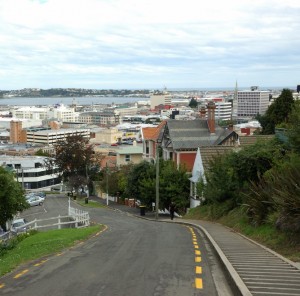 Did you see the steps in the foreground of the photo above? Being up on the hill gives us nice views, but it also gives us steep walks down to the university and the city center, which are both less than a mile away.
Did you see the steps in the foreground of the photo above? Being up on the hill gives us nice views, but it also gives us steep walks down to the university and the city center, which are both less than a mile away.
Dunedin was settled by immigrants from Scotland. Those who purchased the land and planned a grid layout for their city had never actually been here and seen the landscape. When they arrived and discovered how hilly it is, they went ahead with their planned city layout. Maybe they thought this was God’s will – they were seeking religious freedom – or maybe they were just stubborn, the result, however, is a city with some really steep streets and one that is claimed to be the steepest in the world. Dunedin became rich with the Otago gold rush. This wealth allowed them to deal with these streets, by inventing a system of cable cars. Later they shared the design with San Francisco. Still later, they ripped them out, much to the dismay of our legs.
The area that we live in seems to be serving mostly as housing for people associated with the university. So there are a lot of interesting old houses, like the two above, which are being lived in, but not maintained in their original glory. Fortunately, the undergraduates – at least as distinguished by the large piles of empty beer bottles being recycled – seem to mostly live further down the hill, and so that up where we are has been quiet and quite pleasant. This is also an area with a broad mix of cultural and ethnic backgrounds. I think that the photo below captures this wonderfully. The birds prancing on the roof are kiwis.
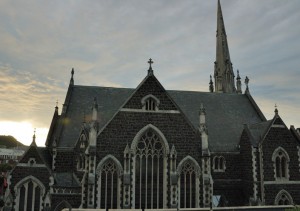 However, the foundation of Dunedin is a set of fine, old buildings, many of them built using similar materials in a common style. The Presbyterian church shown to the right, which is just three blocks from us, is one of those.
However, the foundation of Dunedin is a set of fine, old buildings, many of them built using similar materials in a common style. The Presbyterian church shown to the right, which is just three blocks from us, is one of those.
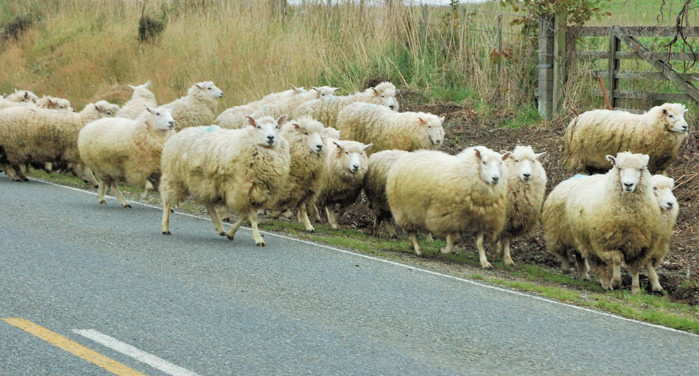
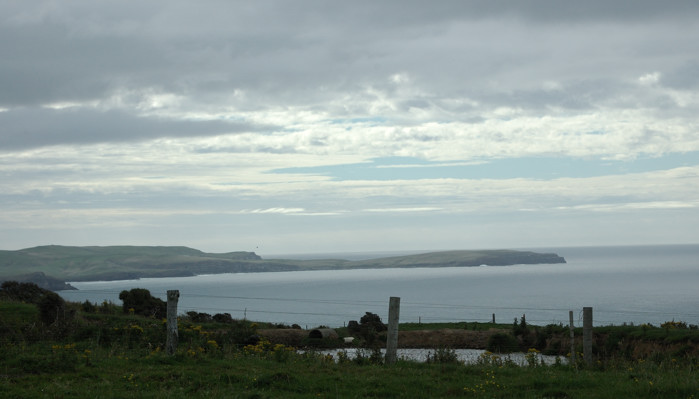
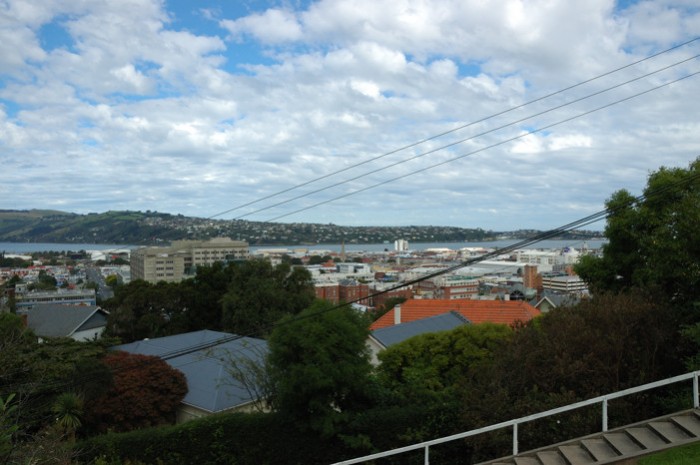
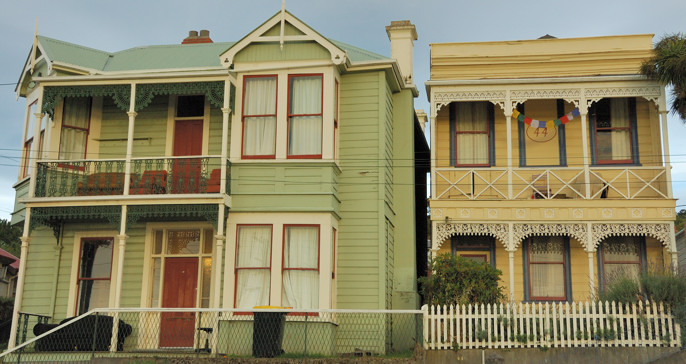
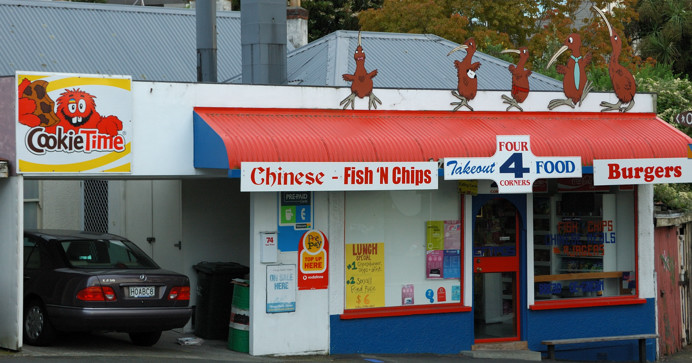
One Comment